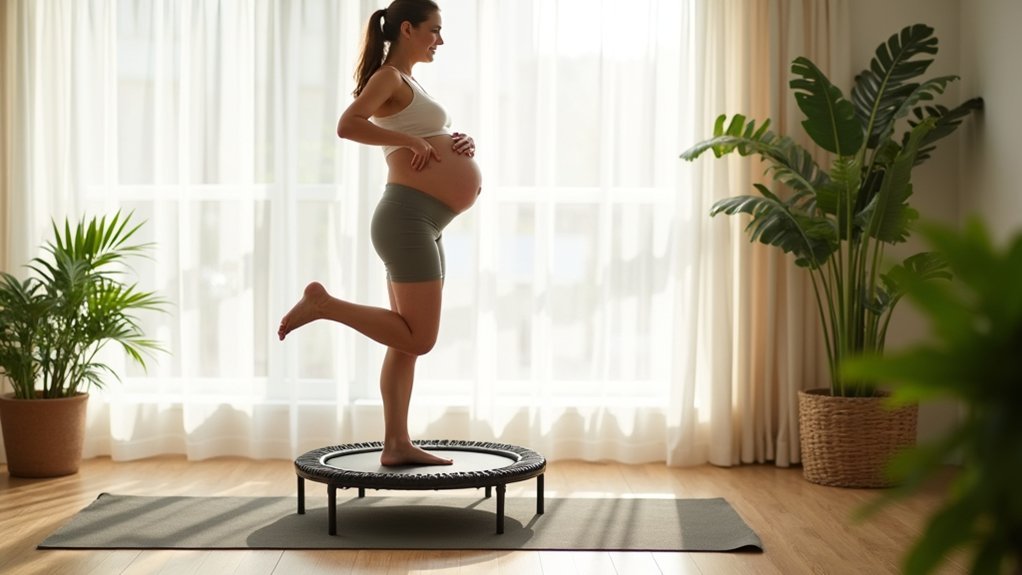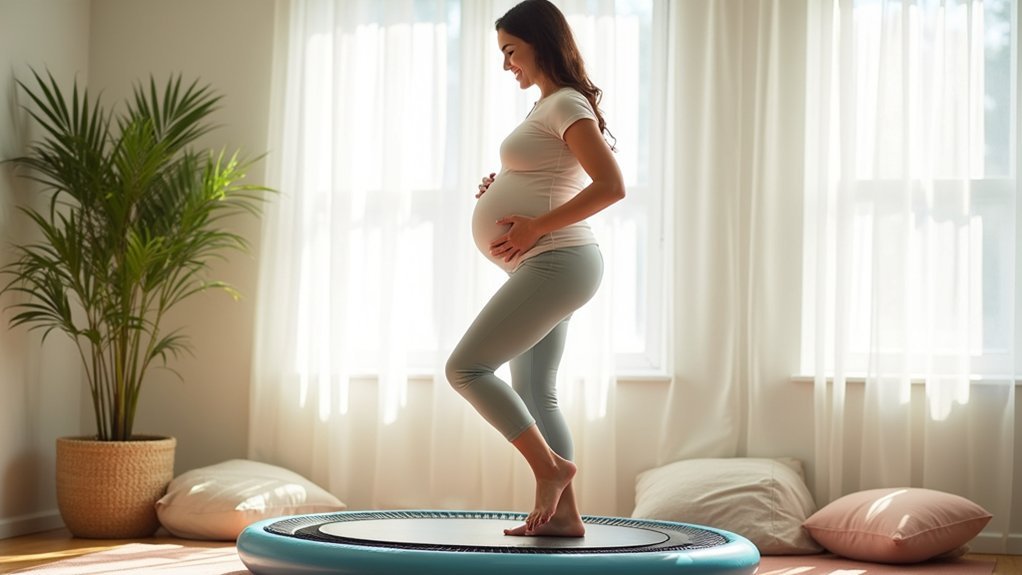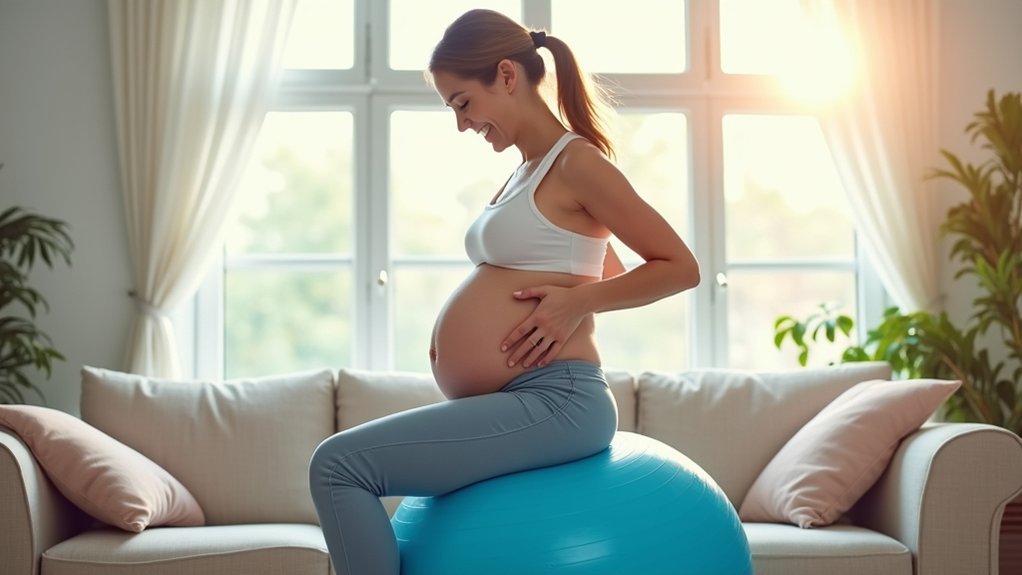Gentle rebounding can safely relieve pregnancy back pain by activating core muscles that support your spine and reducing pressure on lumbar vertebrae. Start with a quality rebounder featuring handlebars and non-slip surfaces, then try 1-5 minute sessions of controlled bouncing. Focus on proper posture, breathe deeply, and stop if discomfort occurs. Always consult your healthcare provider first—especially during high-risk pregnancies. The right bouncing techniques combined with proper recovery strategies will transform your pregnancy comfort journey.
Understanding How Rebounding Benefits Pregnancy Back Pain

While many pregnant women turn to traditional remedies for back pain, rebounding offers unique advantages for expectant mothers. The gentle bouncing motion activates core muscles that directly support your spine, particularly the transversus abdominis and pelvic floor muscles essential for proper posture.
Unlike high-impact exercises, rebounding’s elastic surface absorbs shock, reducing pressure on your lumbar vertebrae while still providing effective muscle engagement. This low-force loading is especially beneficial as pregnancy hormones loosen your ligaments. For pregnant women, it’s important to practice low impact exercises that keep one foot on the mat to protect pelvic floor health.
The rhythmic movement stimulates lymphatic circulation, helping reduce inflammation in back muscles. You’ll also experience natural endorphin release during rebounding sessions, which can decrease pain perception.
Bounce your way to natural pain relief through improved lymphatic flow and mood-boosting endorphins.
The best part? You can easily adjust intensity based on your comfort level, making it adaptable throughout your pregnancy journey.
The Science Behind Low-Impact Bouncing for Spinal Relief
When your pregnant body experiences low-impact bouncing, a fascinating series of physiological responses occurs that can greatly alleviate back pain. The gentle motion distributes pressure evenly across your spine, reducing the mechanical stress that intensifies during pregnancy.
Your core and back muscles engage during bouncing, strengthening the very support system your changing body needs. As you bounce, your joints move through gentle ranges of motion, maintaining essential flexibility without strain.
The temporary adjustments to gravitational forces provide welcome relief from the constant forward lean that strains your lower back. Evidence suggests these movements enhance circulation and promote deeper breathing, which further reduces muscle tension. These exercises work well because they help address mechanical changes in facet joints and back muscles that contribute significantly to pregnancy-related low back pain.
While the research quality varies, stability ball exercises have shown significant benefits for pregnant women struggling with back discomfort.
Choosing the Right Rebounder for Your Pregnancy Journey

When selecting a rebounder for pregnancy back pain relief, you’ll want to prioritize models with essential safety features like handlebars and non-slip surfaces.
Guarantee your chosen rebounder has an adequate weight capacity that accommodates your changing body throughout pregnancy.
Low-impact rebounders, particularly those with bungee cords rather than springs, offer the gentlest bounce for your sensitive spine and joints. Remember to always consult healthcare providers before beginning any rebounding routine during pregnancy.
Safety Features Matter
Every expectant mother deserves a rebounder that prioritizes safety above all else.
When selecting your pregnancy rebounder, insist on non-slip surfaces with rubberized, textured mats that maintain stability as your center of gravity shifts throughout pregnancy.
Look for superior shock absorption from quality springs or bungees that minimize impact on your joints and pelvic floor.
Secure frame construction is non-negotiable—choose models with wide bases, reinforced joints, and ideal weight distribution to prevent wobbling during use.
Don’t overlook quick-release safety mechanisms that allow immediate disassembly in emergencies. Always consult with your healthcare provider before beginning any trampoline exercise routine during pregnancy.
These features should require minimal force to activate yet pass rigorous stability tests.
Finally, verify your rebounder aligns with your healthcare provider’s recommendations, offering adjustable intensity levels appropriate for each trimester and your specific pregnancy needs.
Consider Weight Capacity
Selecting a rebounder with sufficient weight capacity represents one of the most critical safety decisions you’ll make during your pregnancy fitness journey.
Different models offer varying support levels – the Spring Studio Pro supports up to 130 kg, while the Bi-Fold Studio Pro handles only 80 kg.
As your pregnancy progresses, your weight will naturally increase, so choose a model that accommodates not just your current weight but your anticipated maximum. The Bungee Studio Pro (100 kg capacity) or Neon Studio Pro (90 kg) might be suitable depending on your needs.
Don’t compromise on this specification – insufficient weight capacity can lead to instability during exercise, potentially causing injury. Personal fitness history may significantly influence which model is appropriate for your specific situation.
Consult your healthcare provider about your exercise plans and match their recommendations with a rebounder that offers appropriate support throughout your pregnancy.
Low-Impact Rebounders Best
The three most critical features for pregnancy-safe rebounding are low-impact surfaces, stability mechanisms, and pelvic floor protection.
When shopping for a rebounder, look for models with specialized elastic bands or spring systems that absorb 80-90% of impact forces, protecting your changing body and weakening pelvic floor.
Choose rebounders with adjustable handlebars for balance support as your pregnancy progresses. The surface should offer medium-firm elasticity to prevent excessive intra-abdominal pressure while still providing therapeutic bounce benefits. Due to potential balance issues during pregnancy, a handlebar is not just recommended but necessary for maintaining stability and preventing falls.
- Models with TÜV or CE safety certifications guarantee proper weight distribution
- Rebounders with non-slip matting prevent dangerous falls during pregnancy
- Adjustable spring tension allows customization throughout each trimester
Always check with your healthcare provider before starting any rebounding routine during pregnancy.
Starting Your Pregnancy Bounce Routine Safely

As your body undergoes significant changes during pregnancy, starting a bouncing routine requires careful consideration of safety factors. Your ligaments relax due to hormonal shifts, increasing joint mobility but also raising injury risk.
Meanwhile, your center of gravity changes as weight redistributes, affecting balance.
Exercises like brisk walking can be an excellent alternative when bouncing feels too intense, as it provides moderate-intensity aerobic activity without straining relaxed ligaments.
Before beginning, consult your healthcare provider for personalized guidance. Start slowly with gentle bouncing movements that don’t strain your joints or challenge your balance. Always listen to your body—stop immediately if you experience pain, dizziness, or discomfort.
Avoid high-impact movements, jumping, or exercises that involve lying flat on your back in later trimesters.
Remember to stay hydrated throughout your routine and give yourself extra time for warm-up and cool-down phases to protect your more flexible joints.
5-Minute Gentle Rebounding Sequences for Daily Relief
Gentle rebounding sequences offer pregnancy-specific back relief in manageable daily doses. Start with 1-5 minute sessions, incorporating mini-bounces that mobilize your lumbar spine while maintaining upright posture.
Remember to warm up with gentle stretches before starting and make adjustments throughout your pregnancy as your body changes.
Prioritize gentle preparation and adapt your routine as your pregnancy journey and changing body require different support.
- Mix morning mini-bounces with birthing ball exercises to reduce stiffness and improve circulation when you need it most
- Alternate between forward and backward bounces to engage core muscles that support your changing spine
- Complement your routine with figure-8 movements on a birthing ball to relax tight hip and back muscles
Since over 80% of pregnant women experience back pain, gentle rebounding can provide much-needed relief when combined with other recommended exercises.
Always listen to your body and stop immediately if you experience discomfort or pain during your rebounding practice.
Core Stabilization Bounces to Support Your Changing Body
Core stabilization bounces work wonders for pregnant bodies by targeting deep abdominal muscles that support your changing spine and pelvis. The transverse abdominis—your internal corset—activates during gentle rebounds, stabilizing your spine while distributing your baby’s weight evenly.
Coordinate your breathing with each movement: inhale as you land, exhale as you lift. This technique minimizes pressure on your abdominal wall and prevents strain on your linea alba. For optimal outcomes, consider working with a physiotherapy specialist who can assess your specific needs and modify exercises accordingly.
Keep bounces low and controlled, maintaining a slight forward lean to counterbalance your belly. For ideal results, try 1-2 minute intervals with proper form rather than longer sessions.
These controlled movements enhance your proprioception as your center of gravity shifts, reduce lumbar compression, and counter pregnancy-related hyperlordosis—all while preparing your core for labor’s demands.
Posture-Improving Rebounder Techniques
Pregnancy-induced postural changes respond remarkably well to targeted rebounder techniques that realign your spine while minimizing joint stress.
Try wide-stance hip rolls to improve pelvic mobility and reduce lower back strain as your center of gravity shifts. Controlled lateral weight shifts will strengthen your oblique muscles, helping maintain an upright torso when standing or sitting. The elastic rubber ring technology provides lower recoil that minimizes strain while strengthening core muscles.
Your thoracic spine needs special attention as your pregnancy progresses. Perform shoulder rollbacks synchronized with gentle rebounds to release trapezius tension that contributes to slouching. Elevated arms in a “W” position during micro-bounces effectively counteract kyphosis tendencies from increased breast weight.
- Practice heel-to-toe rocking motions to activate postural chains from feet to neck
- Incorporate neck retraction exercises to combat forward-head posture
- Use static holds with handlebar support to stabilize your core and shoulders
Combining Stretches With Gentle Bouncing for Maximum Relief
While traditional stretching provides significant relief, integrating these movements with gentle rebounder bouncing creates a synergistic effect that can dramatically reduce pregnancy back pain.
Try combining low back stretches with brief bouncing sessions to improve circulation and enhance flexibility.
Start with pelvic tilts followed by 30 seconds of gentle bouncing, then shift to a modified child’s pose using your fitness ball for support.
For thorough relief, incorporate figure-8 movements while seated on your birthing ball between bouncing intervals. When performing torso rotations, ensure your legs are crossed comfortably to maintain proper alignment and maximize the stretch’s effectiveness.
Always consult your healthcare provider before starting this routine, especially if you have a high-risk pregnancy.
Stop immediately if you experience pain, and use proper support for all positions.
Remember to breathe naturally throughout each exercise and avoid overstretching—hold positions for just 5-10 seconds.
Trimester-Specific Rebounding Modifications
As your pregnancy progresses through each trimester, your rebounding exercises need specific modifications to guarantee both safety and effectiveness. Your body’s changing center of gravity, growing baby, and increasing hormone levels all impact how you should bounce.
- First trimester: Start with gentle bouncing on a stability ball while maintaining neutral spine alignment and engaging your pelvic floor with each movement.
- Second trimester: Add lateral movements on the ball, shorten exercise intervals to 5-10 minutes, and shift to wall ball squats as your bump grows. Focus on maintaining proper form and monitor your Rate of Perceived Exertion to ensure you’re working at an appropriate intensity of 6-8 on a 1-10 scale.
- Third trimester: Focus on pelvic mobility with gentle seated bouncing, incorporate figure-eight hip rotations that mimic natural labor movements, and prioritize exercises that don’t require standing.
Signs Your Body Needs a Different Approach
Your body communicates through pain and discomfort when current exercises aren’t serving your pregnant frame. If your back pain intensifies despite regular rebounding or you’re experiencing limited mobility affecting daily activities, it’s time to reassess your approach.
Watch for posture changes, pelvic misalignment, or an uneven gait—these indicate your body’s alignment needs attention. When your current exercise routine fails to improve flexibility or strengthen your core, you’re likely not engaging the right muscles. Consider incorporating pelvic tilt exercises which can effectively stabilize your lower back during pregnancy.
High-risk pregnancies, multiple gestations, or pre-existing back issues require extra caution. If you’re uncertain about proper techniques or your pain doesn’t respond to self-care efforts, don’t hesitate to seek professional guidance.
Persistent sleep disturbances due to discomfort also signal it’s time for a new strategy.
Partner-Assisted Rebounder Exercises for Back Support
Partner-assisted rebounding can transform your pregnancy back pain management through gentle bounces that strengthen core muscles while reducing joint strain.
Your partner’s support provides essential balance assistance during exercises, promotes proper alignment, and offers emotional reassurance that enhances your overall experience. Rebounding provides rehabilitation benefits without placing impact on your joints, making it an ideal exercise for pregnant women experiencing back pain.
Always prioritize safety by maintaining low-impact movements, securing healthcare provider approval, and communicating any discomfort to your partner immediately.
Gentle Bounce Basics
When pregnancy back pain strikes, gentle rebounding exercises with a partner’s support can provide tremendous relief while maintaining safety.
Focus on low-intensity, controlled movements that maintain your balance while activating core-supporting muscles.
With your partner nearby for stability, try these effective techniques:
- Health Bouncing: Stand with feet shoulder-width apart and gently bounce without your feet leaving the rebounder surface—this reduces impact while improving circulation.
- Walking in Place: Slowly lift each foot as if walking, keeping movements small and deliberate to protect your joints.
- Supported Side-to-Side: With your partner holding your hand, gently shift weight from one foot to the other to ease lower back tension.
Light rebounding workouts on a trampoline may help alleviate stress on your knees and hips that occurs due to added pregnancy weight.
Always consult your healthcare provider before starting any pregnancy exercise routine.
Partner Support Benefits
Exercising with a partner during pregnancy transforms simple rebounder routines into powerful therapy for back pain relief. Your partner provides essential stability during bounces, preventing falls while allowing you to focus on proper form and breathing techniques.
This team approach offers benefits beyond physical safety. Your partner gains valuable insight into pregnancy challenges, creating deeper empathy and connection. Rebounding is particularly beneficial as it’s low-impact exercise that reduces stress on your already strained joints while still providing effective workout benefits.
They’ll learn to adjust exercise intensity based on your comfort level and provide resistance that enhances muscle strength without strain.
The emotional support during workouts boosts your motivation to maintain consistent exercise. You’ll both experience improved circulation and mood elevation from the shared endorphin release.
These partner-assisted routines easily integrate into your daily schedule, creating a convenient home workout that relieves back pain while strengthening your relationship.
Safety First Approach
Safety must govern every aspect of prenatal rebounder exercises, especially with the increased fall risks during pregnancy. Always secure partner assistance when rebounding to provide stabilization and distribute load properly. Your partner should stand behind the rebounder, holding your waist during controlled bounces while monitoring your posture to maintain neutral spine alignment. Avoid exercising on the rebounder in hot, humid environments as this increases risks of overheating and dehydration during pregnancy.
- Medical clearance is non-negotiable – consult your obstetrician before starting, especially with pelvic girdle pain or diastasis.
- Limit bounce height to 2-3 inches maximum while wearing shock-absorbing footwear for joint protection.
- Cap sessions at 5-10 minute intervals with frequent rest periods, prioritizing core engagement over bounce intensity.
Remember that pregnancy-related ligament laxity increases your injury risk, so focus on gentle “health bouncing” rather than vigorous jumping movements.
Transitioning From Floor Exercises to Rebounding
As your pregnancy progresses, shifting from floor exercises to rebounding can offer welcome relief for your aching back while maintaining fitness.
Safety should be your primary concern during this change—avoid jerky movements that could strain your changing body.
Start slowly by incorporating stability exercises like pelvic tilts on a birthing ball before moving to the rebounder.
Prepare your body with gentle birthing ball exercises before embracing the rhythmic bounce of rebounding.
When you’re ready to bounce, wear supportive gear and choose equipment with safety features like handrails or stability bars.
Focus on gentle core engagement during rebounding sessions to strengthen muscles that support your lower back.
The controlled movement provides improved circulation and posture support while reducing swelling—benefits particularly valuable during pregnancy.
Be mindful that the center of gravity shifts throughout pregnancy, which can affect your balance during rebounding exercises.
Listen to your body throughout this progression and stop if you experience discomfort or pain.
Creating a Sustainable Pregnancy Bounce Schedule
A well-structured rebounding routine offers pregnant women the perfect balance between staying active and managing back pain. Your schedule should adapt to each trimester with appropriate modifications that prioritize safety while still delivering relief.
Keep your rebounding sustainable by following these trimester-specific guidelines:
- First Trimester: Combat morning sickness with shorter 10-15 minute sessions, focusing on gentle health bounces and proper hydration.
- Second Trimester: Incorporate stability bars as your center of gravity shifts, and limit sessions to 30 minutes with mandatory 2-minute rest periods every 10 minutes.
- Third Trimester: Widen your stance, reduce bounce height further, and consider having a spotter present after 28 weeks for added safety. Avoid rebounding while lying flat on back during this trimester as it can restrict blood flow.
Remember to monitor your perceived exertion rather than heart rate, ensuring you can maintain conversation throughout your session.
Post-Workout Recovery Essentials for Pregnant Rebounders
After your rebounding workout, you’ll need gentle rehydration through small, frequent sips of water infused with electrolytes to prevent dehydration and muscle cramps.
Recovery breathing techniques, like diaphragmatic breathing while lying on your side, can help engage your core and reduce back tension. Diaphragmatic breathing provides relaxation and core stability benefits within days after childbirth if you’re in the postpartum period.
For ideal rest, try alternating between left-side positioning with a pregnancy pillow and supported seated postures that maintain proper spinal alignment.
Gentle Hydration Techniques
Proper hydration forms the cornerstone of post-workout recovery for pregnant rebounders. As your blood volume naturally increases during pregnancy, your fluid requirements rise notably, especially after exercising. Always warm up and cool down properly during exercise sessions to maintain safe circulation and prepare your body for hydration absorption.
Aim to drink water immediately following your rebounding session and monitor your urine color—light yellow indicates good hydration.
- Electrolyte balance: Add potassium and calcium through bananas and milk to support muscle recovery after rebounding
- Climate awareness: Choose cooler environments for your rebounding workouts to prevent excessive fluid loss
- Hydration schedule: Consume 7-10 ounces of fluid every 10-20 minutes during exercise and continue hydrating throughout the day
Remember that if you’re breastfeeding postpartum, your hydration needs remain elevated, making consistent fluid intake essential for your recovery journey.
Recovery Breathing Methods
Effective breathing techniques provide essential recovery benefits for pregnant women after rebounding sessions. By practicing diaphragmatic breathing—where your abdomen expands while your chest remains still—you’ll enhance oxygen flow to recovering muscles while promoting relaxation.
After stepping off your rebounder, place one hand on your chest and another on your abdomen. Inhale deeply through your nose for 4 counts, feeling your belly rise, then exhale slowly for 6 counts. Continue this pattern for 2-3 minutes to achieve full relaxation.
These breathing exercises not only reduce physical tension but also engage your core and support pelvic floor recovery. Pelvic floor dysfunction is a common condition during pregnancy that can be effectively addressed through proper breathing and exercise techniques.
As your pregnancy progresses, adapt these techniques to accommodate your changing body. Always listen to your body’s signals and consult your healthcare provider before incorporating new recovery methods.
Rest Position Options
Selecting the right rest positions after your rebounding workout is essential for alleviating pregnancy-related back pain and promoting muscle recovery. Focus on positions that maintain spine neutrality while allowing your muscles to decompress.
The supine pelvic tilt works wonders for relieving lower back pressure—simply lie back with knees bent and gently press your spine into your mat. If you’ve had a C-section, try the side-lying wall contact position instead, keeping your back flush against a vertical surface for ideal alignment. It’s important to consult with your healthcare provider before attempting any post-pregnancy exercise recovery positions.
- Use firm surfaces like high-density yoga mats for better support
- Cycle between positions every 20 minutes to prevent stiffness
- Incorporate wedge pillows under your knees to reduce lumbar strain
Remember to use the log-roll technique when shifting from lying to seated positions to protect your spine.
Frequently Asked Questions
Can Rebounding Affect My Baby’s Position in the Womb?
Rebounding’s G-forces haven’t been clinically studied during pregnancy. While it might temporarily affect your posture, there’s no evidence it can reposition your baby. Most professionals recommend gentler alternatives for safety.
Is Rebounding Safe After Experiencing Pregnancy-Related Sciatica?
After experiencing pregnancy-related sciatica, you should approach rebounding cautiously. Consult your healthcare provider first, start with gentle movements, maintain proper posture, and stop if you feel pain. Gradually increase intensity as tolerated.
How Does Rebounding Compare to Swimming for Pregnancy Back Pain?
Both help your back pain, but swimming offers more weightlessness and extensive muscle engagement, while rebounding improves circulation and is more accessible at home. You’ll find both are low-impact and strengthen core muscles.
Can Rebounding Help With Pregnancy-Related Pelvic Girdle Pain Too?
Rebounding may help with pelvic girdle pain by gently strengthening core muscles and improving stability. However, you’ll need to start very gradually and consult your healthcare provider first, as evidence is limited.
What Clothing Is Most Supportive During Pregnancy Rebounding Sessions?
For pregnancy rebounding sessions, you’ll need high-rise compression leggings with non-slip waistbands, medical-grade compression garments (with doctor approval), and moisture-wicking tops with four-way stretch fabric that accommodate your growing bump.
In Summary
You’ve now discovered a gentle yet effective way to manage your pregnancy back pain. By incorporating rebounding into your routine, you’re strengthening your core while reducing pressure on your spine. Remember to listen to your body, start slowly, and always check with your healthcare provider. With consistent, safe bouncing sessions, you’ll likely notice improved comfort as you progress through your pregnancy journey.





Leave a Reply